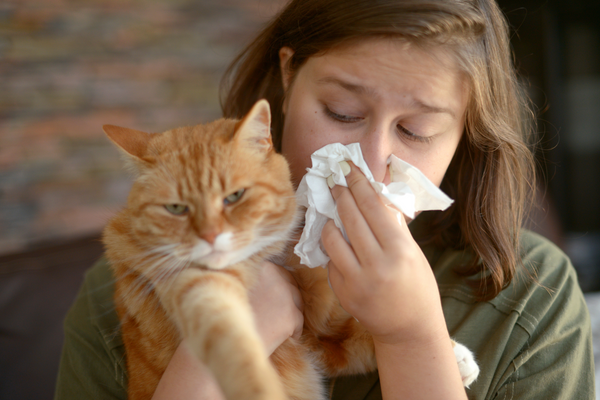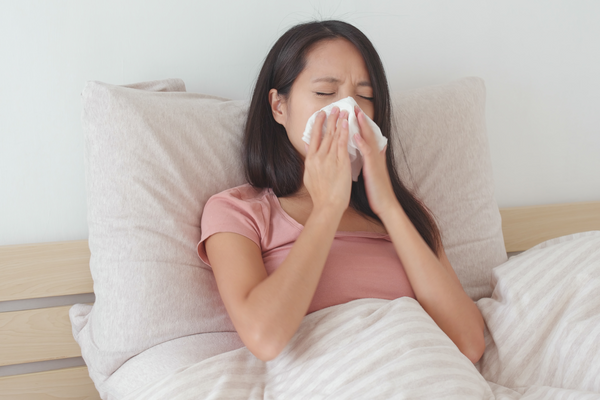How to Clean & Disinfect After Someone in Your Household Has Had COVID-19

As the novel coronavirus continues to spread across the country – and the world – more people may become infected, and many of those will exhibit the symptoms of COVID-19. Thankfully, the majority of people who contract the virus have mild symptoms and can safely recover at home. The U.S. Centers for Disease Control and Prevention (CDC) recommends that individuals with symptoms of the disease go into quarantine and isolate themselves to help prevent spreading the virus to others in the household.
So what happens if you or someone in your home has become infected with the virus, or are self-quarantining at home as a precautionary measure? It’s critical to have an action plan and continuously clean, sanitize, and disinfect the obvious (as well as the not-so-obvious) surfaces the virus can live on around the household. Additionally, once the disease has run its course, the room or rooms that the sick person used – as well as the items he or she came into contact with – will need to be thoroughly cleaned and properly disinfected to help prevent the spread of the virus. According to the CDC, the coronavirus that causes COVID-19, called SARS-CoV-2, may remain viable from hours up to several days on a variety of surfaces. Cleaning followed by disinfection is recommended by the CDC as a best practice measure for prevention of COVID-19, as well as other viral respiratory illnesses in households and community settings.
If someone in your home is self-monitoring or quarantined with a possible infection, follow these best cleaning practices to help prevent the spread of the novel coronavirus to other household members.
Materials Needed:
- Vital Oxide
- Anti-Allergen Laundry Detergent
- Microfiber cleaning cloths
- HEPA Vacuum
- Face mask
- Disposable gloves

Always Pre-Clean Before Disinfecting
Cleaning, sanitizing, and disinfecting are not the same things and it’s important to understand the difference. All three actions are a critical piece of the hygiene puzzle. Here’s what they mean:
- Cleaning means removing germs, dirt and impurities from surfaces. It does not kill germs, but reduces the number of them on surfaces.
- Sanitizing lowers the number of germs on surfaces or objects to a safe level, as judged by public health standards or requirements.
- Disinfecting means using Environmental Protection Agency (EPA)-registered chemicals to kill germs on hard, non-porous surfaces. This is intended after cleaning to further lower the risk of spreading infection.
Have a Cleaning Strategy
When someone in your household is sick, clean and disinfect surfaces and surroundings daily using a product, like Vital Oxide, that is clearly labeled as an EPA-registered disinfectant that kills 99.9% of viruses and bacteria to most effectively eradicate germs.
If possible, dedicate one bedroom and bathroom for the sick person to use. While the person is ill, have them clean and disinfect the rooms they use daily, if they are well enough to do so. If they are unable, caregivers should take proper precautions while cleaning the rooms, such as wearing a face mask and clean gloves.
Before you expose a surface to a disinfectant, it’s imperative to always clean the surface of all dirt and debris first; A disinfectant cannot do its job if it’s applied to a soiled surface. As outlined above, the process of cleaning can start to reduce germs by removing dirt, grime, and other contaminants that can harbor bacteria and viruses, but it does not reduce the germ-load to the 99.9% level. Once a surface is clean, the disinfectant will be able to get to work. Under lightly soiled conditions, Vital Oxide can be used to pre-clean surfaces before disinfection. Clean and disinfect in two easy steps: First spray and wipe Vital Oxide to remove visible dirt, dust, and grime. Next, spray Vital Oxide and leave behind to disinfect. No need to rinse, simply let it air dry.
Keep in mind that disinfection is not instantaneous, all disinfectants need time to work effectively. Always make sure to apply enough of the solution so that it remains visibly wet for the proper contact time. Vital Oxide is now tested and proven effective to kill the COVID-19 virus, SARS-CoV-2, on hard, non-porous surfaces, with a contact time of just five minutes.
NOTE: In cases where more frequent disinfection of surfaces results in possible buildup of dry disinfectant residue, a wipe down with a moist towel or microfiber cloth of surfaces that come into contact with clothing (such as chairs, benches, etc.) will prevent any possible discoloration of fabrics.
Here are key areas and objects to focus on when someone in your household is sick or self-quarantining as a precautionary measure:
All High-touch Surfaces
It’s easy to remember to clean and disinfect obvious germ hotspots such as bathroom and kitchen surfaces. But other frequently-touched surfaces in our homes need attention, too – think door and fridge handles, the microwave touch pad, railings, banisters, and light switches. For obvious electrical safety reasons, you should never spray anything directly onto a light switch. Instead, spray Vital Oxide onto a microfiber cloth and wipe the light switch and switch plate to remove dirt and oil. Follow up with another cloth lightly dampened with Vital Oxide, wipe to apply, and let air dry to disinfect. For other high-contact surfaces like countertops, faucets, etc., remember to always pre-clean surfaces, and then apply Vital Oxide full-strength directly from the bottle by either spraying, wiping, or fogging to disinfect.
Garbage Cans
Trash cans can quickly become germ magnets when they’re brimming with used sick tissues and other germy remnants. Be sure to empty the contents frequently (don’t forget to wear your disposable gloves while doing so!), wash the inside of the can with hot soapy water, then rinse and dry with a paper towel. Once it’s dry, spray all sides of the can liberally with Vital Oxide and allow it to air dry to disinfect and deodorize.
Machine-Washable Soft Surfaces
To clean and sanitize washable soft surfaces, such as small throw and area rugs, upholstery covers, pillow covers, and drapes, always follow the maker’s care instructions on how to best clean. Most throw rugs, sofa and pillow covers, and drapes can be washed in the washing machine – but before you toss them into the washer, make sure to remove as much dirt, dust, pet hair and other debris as possible by vacuuming with a HEPA vacuum or by shaking outside.
To launder, use an Anti-Allergen Laundry Detergent to cut through grime and to neutralize common indoor allergens like dust mites, pet dander, molds, mildew, smoke, and pollen. Add ½ cup to 1 cup Vital Oxide to the washer (depending on the size of the load) along with the detergent to sanitize. Dry according to care instructions.
Tech & Electronics
Electronic devices that are used by the whole family, such as remote controls, touch screens, tablets, computer keyboards, and game console controllers, may also be microbe-magnets. While it may be tempting, never spray any kind of liquid directly onto electronics. Instead, start by cleaning the device with a damp microfiber cloth (either lightly sprayed with water or Vital Oxide) to wipe away dirt and grime, followed by a clean cloth spritzed with a Vital Oxide to get rid of germs and viruses. A cotton swab dipped in Vital Oxide can be handy to clean and de-germ the small areas between buttons.
Hard Floors
To clean and sanitize hard floors, start by vacuuming thoroughly with a HEPA-type vacuum to get rid of loose dirt and dust, and then mop with a solution of 1 part Vital Oxide to 9 parts water to kill germs. To reduce the germ load on your floors, it’s best to make your home a “shoe-free” zone, as shoes can potentially bring in germs.
Laundry
Clothing, bedding, towels, and other fabric items can harbor pathogens that make others sick, and research has shown that a simple wash cycle might not be enough to get a complete clean. Even worse, just one item of contaminated clothing is enough to soil nearly an entire load of laundry, according to one study from the University of Arizona. Respiratory viruses like SARS-CoV-2 (the novel coronavirus that causes COVID-19) as well as cold and flu viruses can survive for hours – or even days – on soft surfaces like clothing, bedding, and linens. To sanitize contaminated laundry, use your regular hypoallergenic laundry detergent along with ½ to 1 cup Vital Oxide (full-strength, directly from the bottle), depending on the size and soil level of the load. Dry as you normally would, and clean your washer after completing the load to avoid cross-contamination. Simply add ½ cup of Vital Oxide to your washing machine, set the temperature to “hot”, add an extra rinse cycle, and run the cycle with your washer empty.
Don’t Forget! Wash & Sanitize Your Cleaning Cloths
When it comes to hygienic cleaning, a ‘one cloth fits all’ approach is no good. In fact, it can even lead to cross-contamination. If you use any sort of reusable cleaning cloths or sponges, switching to a clean one when you finish cleaning one surface and before you move on to another will help stop the spread of pathogens. Microfiber cloths will clean most effectively when you use them with warm or hot water (this helps open out the fibers) and when you fold the cloth into a pad, which helps the cloth make the best possible contact with the surface you’re cleaning. Remember, reusable cleaning cloths will always need to be machine washed and sanitized after you’ve finished cleaning.
At The Ecology Works, we’re proud to offer our revolutionary disinfectant that is powerful enough to kill 99.9% of viruses and bacteria without harsh chemicals. Follow us on Instagram @ecologyworks to learn more about the science behind our products, as well as tons of great tips on cleaning and living an eco-friendly lifestyle. If you have any questions, please feel free to Contact Us or message us on Facebook. No question is too small. We’re all in this together and we're here to help.




